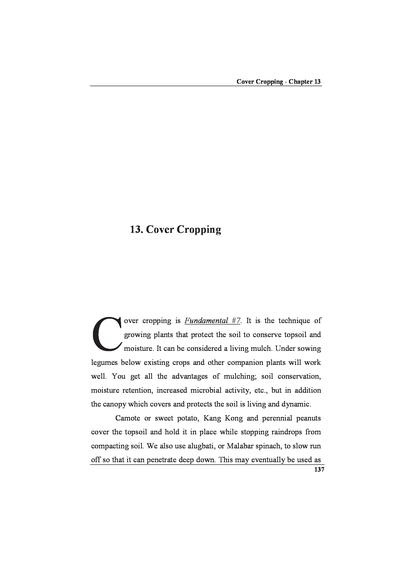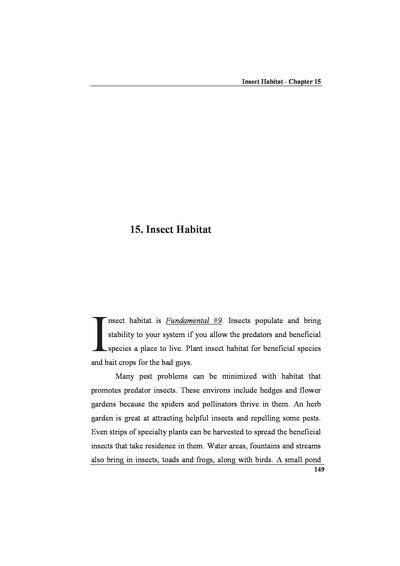This helpful book has been provided free of charge by the Aloha House to the wider network. ECHO Asia believes that these resources are well researched and useful to the majority of ECHO Asia network members. For more information, please contact Keith Mikkelson, the author.
===========================================================
This book is an important work for tropical agriculture. There are very few resources that are truly “organic” and practical for the everyday farmer in the tropical setting. This book covers material that is extremely useful for the day-to-day operation of a farm or garden. It contains planning material that takes into account logistics as well as timetables.
This is not a guide for the agronomy student. I have identified several species that work well for us, but I do not have a planting guide for rice or corn or vegetables. These guides are readily obtained from seed suppliers and general horticultural works. If the reader looks carefully, he will find that I have given a system for natural fertilization in place of the chemical recommendations by traditional methods. Some creative adaptation will be required if your conditions and climate vary. We have a high acid clay soil that was rainforest at one time. Over the years a cogan grass has established itself. That is our starting point and our formulas can be changed for particular challenges that the reader may be facing.
This is not a How-to-do-it manual. Rather, this is a HOW-WE-DO-IT book based on my “Sustainable Agriculture in the Tropics” manual. It has been used to train and equip hundreds of small-scale farmers and gardeners in the natural farming adventure. It is an adventure worth taking, as few things in life will improve general health and well being as much as quality food products grown to their full potential.
Keith O. Mikkelson – Fall 2005
29 Issues in this Publication (Showing issues 31 - 12) Previous | Next
Sustainable Agriculture Book - Chapter 9 Companion Planting - 2005-01-20
Companion planting is Fundamental #3. It is also called inter cropping. These crops are used for insect control, to make wind blocks, and they promote soil conservation. When harvested, they are used for compost and feed for livestock. Companion plants also create a desirable mulch and green fertilizer. Under sowing is a very popular means of companion planting also.
Some plants give benefits that help others grow. Tomatoes do well with carrots because the carrots stimulate the growth of tomatoes. Others, like marigold, ward off certain insects. Onions prevent the carrot fly from infesting the root with eggs. Papaya wards off corn pests.
Sustainable Agriculture Book - Chapter 10 Composting - 2005-01-20
Composting is Fundamental #4. Compost will build up organic matter and create humus for your soil. The finished product of decomposition is called compost. Composting is a controlled process in which we capture a high percentage of nutrients from our crop residue and return it back to the soil in a form that is very nutritious. Composting is as much an art as a science by which we create an environment for the natural processes of nature to work efficiently. Remember, we feed the soil, and the soil will feed the plant! We will discuss the classic aerobic systems that work well for us. Then we will highlight our anaerobic processes and incorporate them with planting. We also have a very successful Vermiculture operation we will outline for you.
Sustainable Agriculture Book - Chapter 11 Green Fertilizers - 2005-01-20
Green fertilizer is Fundamental #5. It feeds the next crop efficiently. As you plow crop residue into the soil it will eventually become humus and fertilizer for following crops. It is a form of composting, in which materials do not need to be transported to a mixing/composting site. You could call it field composting.
Economical on a large-scale, green fertilizers will build up the organic matter in the soil. Many of the professional farmers grow a crop to flowering and plow it under before fruiting. This will maximize the biomass and minimize nutrient and energy loss.
Sustainable Agriculture Book - Chapter 12 Mulching - 2005-01-20
Mulching is Fundamental #6. It will conserve topsoil and moisture, as well as provide fertilizer. When straw or crop residue covers the topsoil, it holds it in place while stopping raindrops from compacting soil. Areas with heavy rain require more plowing.
It also slows down rain run off so that moisture can penetrate down to the roots. Erosion is costing farmers valuable organic matter and trace elements. When you mulch, the rain percolates gently into the soil and goes much deeper than when exposed to wind and rain. In dry climates wind erosion can be worse than rain erosion.
Sustainable Agriculture Book - Chapter 13 Cover Cropping - 2005-01-20
Cover cropping is Fundamental #7. It is the technique of growing plants that protect the soil to conserve topsoil and moisture. It can be considered a living mulch. Under sowing legumes below existing crops and other companion plants will work well. You get all the advantages of mulching; soil conservation, moisture retention, increased microbial activity, etc., but in addition the canopy which covers and protects the soil is living and dynamic.
Camote or sweet potato, Kang Kong and perennial peanuts cover the topsoil and hold it in place while stopping raindrops from compacting soil. We also use alugbati, or Malabar spinach, to slow run off so that it can penetrate deep down. This may eventually be used as forage, grazed, harvested, composted or used as a green fertilizer. Be sure to pull back the cover crop when starting seedlings. Most plants will compete for nutrients and the established canopy usually wins. The perennial peanut grows right up to our papaya trunk without inhibiting it. However, corn, we have found, needs more space around the seeded area to establish itself.
Sustainable Agriculture Book - Chapter 14 Minimal Tillage - 2005-01-20
Minimal Tillage is Fundamental #8. It will preserve soil life and structure, save labor and increase profits. The soil food web is disturbed when continual plowing is practiced. The hoofs of the carabao (water buffalo) or tractor compact the soil while the plow causes disruption in microorganism activity.
As the soil compacts, a pan develops, where sub soil at the depth of the plow can form a barrier layer that roots cannot penetrate. Then rainwater is kept from penetrating the ground and easily floods. The water is stuck at the upper levels of the soil. So are the earthworms.
Sustainable Agriculture Book - Chapter 15 Insect Habitat - 2005-01-20
Insect habitat is Fundamental #9. Insects populate and bring stability to your system if you allow the predators and beneficial species a place to live. Plant insect habitat for beneficial species and bait crops for the bad guys.
Many pest problems can be minimized with habitat that promotes predator insects. These environs include hedges and flower gardens because the spiders and pollinators thrive in them. An herb garden is great at attracting helpful insects and repelling some pests.Even strips of specialty plants can be harvested to spread the beneficial insects that take residence in them. Water areas, fountains and streams also bring in insects, toads and frogs, along with birds. A small pond with non-stagnant water will bring in more helpers for your garden. Birds are very helpful in the ecology of your farm. Many bird species eat large quantities of insects every day.
Sustainable Agriculture Book - Chapter 16 Livestock Integration - 2005-01-20
The best way to finish off your dream farm or garden is to balance it with a small livestock unit. Animal integration is Fundamental #10. It will create a low cost high quality fertilizer source as well as produce food to eat.
Livestock properly managed will bring the tropical farmer higher profits than some market vegetables and most grains. We raise goats, chickens and hogs. Our goats graze and browse as well as feed on fermented grains. Some crop residues are fed to the goats; it reduces feed costs and their manure will reduce fertilizer costs. We cut and carry feed stock fresh while some confined grazing is practiced. Concentrated grains are used as a supplement to pasturage. Grains are fermented with beneficial microbes to increase feed conversion and act as a probiotic, eliminating all medications. The feed creates natural vitamins and health enhancing components that protect livestock because EM is active in it. The cost of the EM is far less than antibiotics and vitamin shots and replaces all antibiotics. Our goatbreeding program been successful; we’re expanding it. We are looking for a cow to pasture; we’ve some premium legumes for grazing.
Sustainable Agriculture Book - Chapter 17 Resource Recovery Tour - 2005-01-20
Unused resources are called waste. If you use the waste in your compost, you turn it into fertilizer. It’s no longer waste, right? There’s no longer any need to have organic waste filling our landfill. We can use all of it in our system. For our purposes the opposite of waste would be useful. Call it useful, don’t call it waste. We ferment our kitchen waste and it becomes useful. Use your useful materials in the garden!
Sustainable Agriculture Book - Chapter 18 Planning Session - 2005-01-20
Plans should be drawn up before any effort is wasted. Think through your traffic routes and flow of materials. Integrate your resource recovery plan in this process. Set your goals and lay down the steps that you think are needed as you see it now. Write it down; it will be a flexible starting point. Even the best laid plans can fail, but remember, you are gathering data from your experience and can progress even when you make a mistake or are broadsided by unforeseen circumstances.








